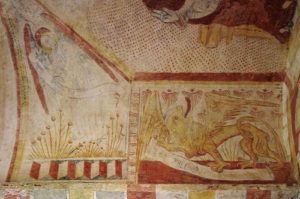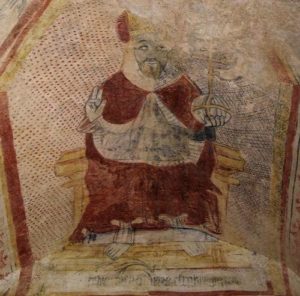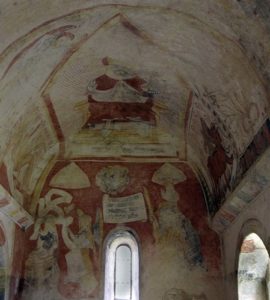You have to want to find this place as it is about a mile from the village. On top of the plateau, surrounded by rolling farmland, the church is set in a walled graveyard with many large and splendid tombs. This was the parish church until 1847 when it was in a very poor state of repair and the new church was built in the village. Now, the 12thC bell-tower and a small nave are all that are left of the Romanesque church.
It has a square stone tower with a row of corbels below the louvred bell windows and a pointed roof made of stone tiles. The tiny nave has a herring bone pattern on the walls, characteristic of 11thC work. Originally it would have been 4 or 5 times as long and much higher. It now has a later pantiles roof and the original roof line can be seen on the tower. There is a simple arch above a wooden door into the church. The chancel is now under the tower with a plain stone altar. The nave windows are still the original 11thC windows. The chancel window is larger and later.
The walls and ceiling are covered with frescoes which are described as some of the best in the region. They are mainly shades of reds and yellows. The detail is amazing.They were covered with plaster in the 15thC and only rediscovered in 1980. The oldest are 11thC
There is a leaflet in English in the church describing the frescoes.
There are two small blind arches on the walls which have yellow, red and blue blocks painted round the arch. On the walls between are red circles with red crosses on a yellow background. There is the remains of a black funeral band round the walls. At the top of the wall is a small plinth painted with blue, yellow and red blocks. There are tantalising glimpses of frescoes where the later wall plaster is beginning to peel off.
The chancel vault has red stars on a pale background with a sun and moon, both painted with human faces. At the centre is Christ Pantocrator, clothed in red, who is sitting on a throne, against a red stippled background. In his left hand he holds an orb. His right hand is held high in blessing. His face is outlined in black and has a distinct Arabic look. The degree of detail is amazing from the hair on his beard to his toe nails. He is surrounded by the symbols of the four evangelists. with a very lean lion of St Mark with a long red tongue. The bull of St Luke is a deep red and has wings. St Matthew is represented by a winged angel with a red halo. The eagle, symbol of St John has been lost.
The east wall of the chancel is painted a deep rust colour. On the north side is a fresco of the Annunciation with Gabriel appearing to Mary. On the south side is an image of a bearded St Christopher holding a stick and carrying the Christ Child on his shoulders.
The oldest, 11thC fresco is under the first left hand arch in the chancel. It is a lovely depiction of St Leonard. He was authorised by the king to free the prisoners. The small building at the bottom left represents the prison and two prisoners are kneeling at his feet in thanks. Above two angels endorse his action
On the north wall near the entrance is a 15thC depiction of Hell, represented by Leviathan, a sea monster with his mouth open ready to swallow the damned. Look closely and you can see figures in his mouth. To the left of him is a figure of a woman with a red clock riding a lion, the symbol of lust and one of the seven deadly sins.
On the south wall is part of a depiction of the Last Supper, but only two of the apostles remain. The rest were lost when the nave was shortened. The table is laid out with food and beneath is the name of the apostle. St Jude is drinking. Next to him it looks as if a hand is coming across to take his bread roll….
This is a delightful spot, well away from the village. There was someone tending a grave and a couple of walkers. We had the church to ourselves.
The church door tends to stick and two hands are needed to close it securely. I leant my stick against the door and forgot it. So if it is still there, it belongs to me!










